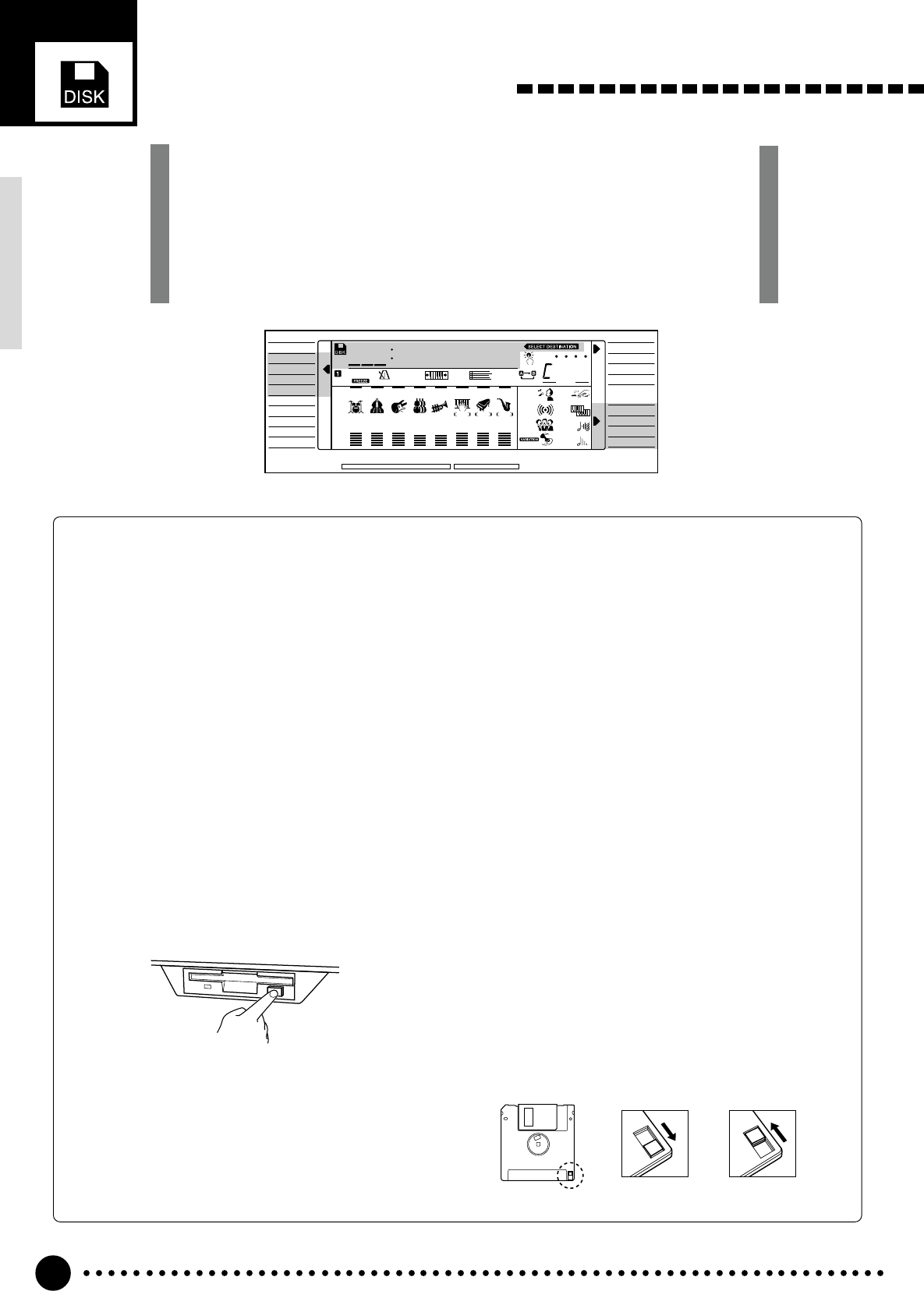
64
Using Floppy Disks
The PSR-620 features a floppy disk drive that allows virtually unlimited
storage of User Songs, User Pad kits (that you have recorded yourself),
User Styles (loaded from Style File Format Style Disks) and Registration
Memory data. PSR-620 disk data can be selected in the same way as the
internal data via the appropriate function display.
The disk drive also allows the PSR-620 to play standard MIDI music files
(format 0) and Yamaha Disk Orchestra Collection disks.
ACCOMP TRACK SONG TRACK
Yamaha
TEMPO TRANSPOSE MEASURE REPEAT CHORD
BEAT
TOUCHMINUS ONE
REVERB DUAL
CHORUS HARMONY
DSP SUSTAIN
RHYTHM BASS CHORD PAD PHRASEACCOMP MELODY
2
MELODY
1
111
ON /
OFF
VOICE
VOL
REGIST
REC REC REC
OTS
801
135102117130 1011011
118 10 a01
VOICE
STYLE
SONG
REGIST MEMORY
MULTI PAD
DUAL VOICE
SPLIT VOICE
HARM
/
ECHO
OVERALL
DIGITAL EFFECT
NORMAL
SPLIT
SINGLE
FINGERED
LOAD
SAVE
DELETE
FORMAT
• Do not insert anything but floppy disks into the disk drive.
Other objects can damage the disk drive or floppy disk.
• Never open the disk shutter by hand or touch the internal
surface of the disk. Dirt, dust, or grease on the disk’s magnetic
surface can cause data errors.
• Never leave disks near a speaker, TV, or other device that
emits a strong magnetic field. Strong magnetic fields can
partially erase the data on the disk.
■ Floppy Disk Handling Precautions
Floppy disks are an inexpensive, convenient, and reliable way
to store your music data. They are not indestructable, however,
and should be handled with care. Observe the following points to
ensure the long-term safety of your disks and data.
Type of Disk
• Use only double-sided double density (2DD) 3.5-inch floppy
disks with the PSR-620.
Taking Care of Your Floppy Disks
• Never attempt to eject a disk during a read or write operation
(i.e. while the disk drive is operating). Doing so can damage
both the disk and the drive.
• Never turn the power ON or OFF while a disk is in the drive.
Always eject the disk before turning the power OFF.
• To eject a floppy disk from the disk drive press the eject button
slowly as far as it will go. Then when the disk is fully ejected,
remove it by hand. The disk may not be ejected properly if the
eject button is pressed too quickly or if it is not pressed in far
enough (the eject button may become stuck halfway with the
disk extending from the slot by only a few millimeters). If this is
the case, do not attempt to pull out the partially ejected disk.
Doing so may damage the disk drive mechanism and/or the
floppy disk. To remove a partially ejected disk, try pressing the
eject button once again or push the disk back into the slot,
then repeat the eject procedure carefully.
• Do not store disks in places exposed to direct sunlight or other
sources of heat. The acceptable storage temperature range is
approximately 4° to 53° C (39° to 127° F).
• Do not store disks in areas subject to extreme dryness or hu-
midity. The acceptable relative humidity range is approximately
8 to 90%.
• Do not store disks in areas contaminated with dust, sand,
smoke, etc.
• Do not place heavy objects such as books on top of a disk.
• Avoid getting floppy disks wet, particularly with oily or sticky
fluids. A disk that has been wet with water should be allowed to
dry naturally before use. Disks contaminated by other fluids can
cause damage to the disk drive and should be discarded.
• Be sure to apply the disk label at the proper position. When
changing the label never cover the old label with a new label;
always remove the old label first.
Head Cleaning
• With extended use the read/write head of the disk drive will pick
up dust and other particles that will eventually cause data er-
rors. If this occurs, clean the head with a 3.5 inch head clean-
ing disk available from most computer supply stores.
Data Backup
• For maximum data security we strongly recommended that you
keep two copies of important data on separate floppy disks.
These disks should ideally be stored in separate locations. This
gives you a backup if one disk is lost or damaged.
Protecting Your Data (Write Protect Tab)
• To prevent accidental erasure of important data, slide the disk’s
write-protect tab to the “protect” position (tab open). If you
attempt to modify the disk when the write-protect tab is set to
ON position, “Protcted” will appear on the display indicating that
the operation is not possible.
Write protect tab ON
(locked-write protected)
Write protect tab OFF
(unlocked- write enabled)


















